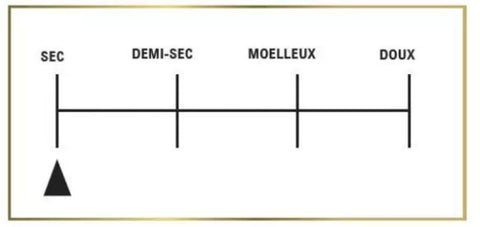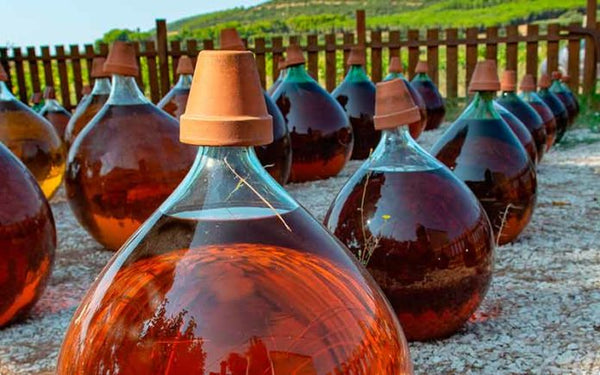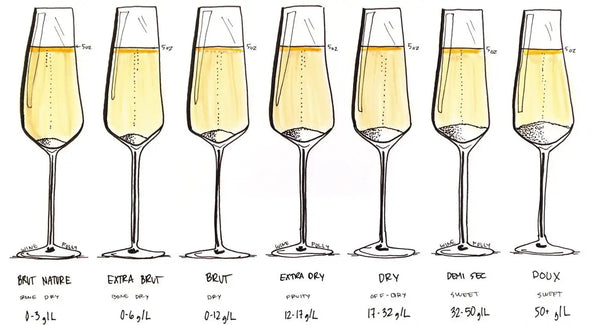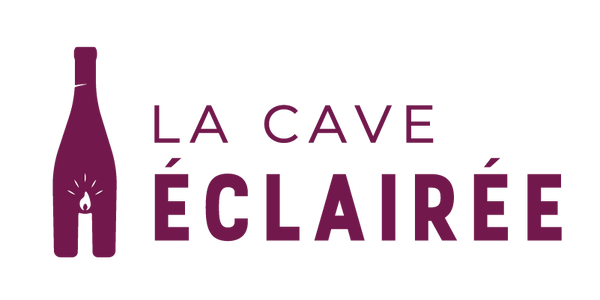But what do they exactly mean ? Do you know where the sugar in wines comes from ? How are sweet wines made? Explanations.
A matter of vocabulary
First of all, let's talk about dry wines. Be careful, this adjective is not used here to characterize the style of a wine but simply informs about the level of residual sugar (or final) contained in a bottle.In this case, a dry wine can contain a maximum of 4g/L of sugar (or 3g for a 75cl bottle). At this level, it is generally imperceptible to the taster. A "dry" wine is therefore a wine with little to no residual sugar. Then, the following categories come: Demi-sec: between 4g and 12g/L Moelleux: between 12g and 45g/L Liquoreux or sweet: more than 45g/L A liquoreux wine is therefore sweeter than a moelleux, which is itself sweeter than a demi-sec.
 Sweetness scale of still wines
Sweetness scale of still wines
Alcoholic fermentation
Now that these terms are clear, let's look at how our sugar ends up in the final bottle.
As you know, grapes naturally contain sugars (like all fruits). Well, except for the very specific case of chaptalization, the sugars found in wines simply come from... the grapes ! Indeed, once the harvest is over, the winemaker carries out what is called alcoholic fermentation.It is at this moment that the sugar present in the grapes is naturally converted into alcohol by microorganisms called yeasts. This is the moment when grape juice becomes wine.
The winemaker can then decide either to let the fermentation go to its end (it stops when the yeasts have no more sugar to consume or when the alcohol level reaches about 15% because they cannot survive beyond that), or to stop it by their own action so that not all the sugar present is converted into alcohol.

Alcoholic fermentation in progress
For example, to produce the Sauternes of Château Haut-Bergeron, the alcoholic fermentation goes to its end.Nevertheless, as the grapes are harvested in overripe conditions and naturally contain a lot of sugars, not all of them are converted into alcohol, and a large portion remains in the bottle for our greatest pleasure.
Conversely, the naturally sweet wines (VDN for insiders) such as those from Mas Amiel in Maury, the Ports like the delicious Tawny 10 years from Quinta da Ervamoira, or the Muscat de Rivesaltes like the one from Domaine des Schistes in Roussillon have had their alcoholic fermentation deliberately stopped by the addition of a wine spirit, bringing the wine above 15% alcohol, thereby killing all the yeasts and leaving the remaining sugar intact.
This addition of alcohol can also take place before fermentation. In this case, all the sugars present in the grapes are preserved. This is the method used for “ liqueur wines ” like Macvin from Jura or Pineau des Charentes. To simplify, these are a mixture of grape juice and alcohol.
Finally, other methods such as cooling the wine and filtering it can be used to eliminate the yeasts. This is the case, for example, to produce the delicious Vouvray demi-sec or moelleux from the François and Julien Pinon estate.

Raising in demijohn of a Vin Doux Naturel
The specific case of sparkling wines
For sparkling wines (crémants, proseccos, champagnes etc.), another classification exists to qualify the levels of residual sugars :
➡️ Brut nature : between 0 and 3g/L
➡️ Extra brut : between 0 and 6g/L
➡️ Brut : between 0 and 12g/L
➡️ Extra dry : between 12 and 17g/L
➡️ Dry : between 17g and 32g/L.
➡️ Demi-sec : between 32g and 50g/L. The same term is used for still wines, so be careful not to confuse them!
➡️ Doux : more than 50g/L. Same note as before.
Besides this semantic difference, the sugar found in the final bottle of sparkling wines does not come from the grapes ! Indeed, at the time of the final bottling of a crémant or champagne, the winemaker will add a liqueur de dosage (or shipping liqueur) to the wine. It is this liqueur, composed of wine and cane sugar, which, depending on its sugar content, will give our bubbles their designation of Extra Brut, Brut, Demi-sec, etc.
Some estates like Veuve Fourny & Fils choose to respect the "grape universe" as much as possible and select for their champagnes a dosage liqueur made from grape sugar! However, this remains a rarity.

Sugar Scale of Sparkling Wines
Conclusion
As you have understood, if the residual sugar present in sparkling wines comes from an external addition and is very generally cane sugar, for non-sparkling wines, the sugar indeed comes (except for chaptalization) from the grapes.
Furthermore, the production of semi-dry, sweet, or dessert still wines can be done in different ways. Either the wine is made from overripe grapes containing a high sugar content and its fermentation stops naturally when the alcohol level becomes too high, or the winemaker decides to voluntarily stop this fermentation by their own means (cold and filtration, adding strong alcohol, etc.).
These choices depend on many factors such as the AOC rules, the grape variety, the climate, or even the winemaker's preference.
In conclusion, I would advise you to pay attention primarily to the notion of balance in the wine tasted rather than the raw figure expressing the sugar in it (except for diabetics😉). Indeed, a high sweetness can be perfectly balanced by a nice acidity and a gourmet aroma, while a wine that is actually less sweet may seem heavy or even cloying if it is not harmoniously constructed.
See you soon at




















1 comment
Merci pour ces informations !